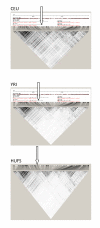A genome-wide association study of serum uric acid in African Americans
- PMID: 21294900
- PMCID: PMC3045279
- DOI: 10.1186/1755-8794-4-17
A genome-wide association study of serum uric acid in African Americans
Abstract
Background: Uric acid is the primary byproduct of purine metabolism. Hyperuricemia is associated with body mass index (BMI), sex, and multiple complex diseases including gout, hypertension (HTN), renal disease, and type 2 diabetes (T2D). Multiple genome-wide association studies (GWAS) in individuals of European ancestry (EA) have reported associations between serum uric acid levels (SUAL) and specific genomic loci. The purposes of this study were: 1) to replicate major signals reported in EA populations; and 2) to use the weak LD pattern in African ancestry population to better localize (fine-map) reported loci and 3) to explore the identification of novel findings cognizant of the moderate sample size.
Methods: African American (AA) participants (n = 1,017) from the Howard University Family Study were included in this study. Genotyping was performed using the Affymetrix® Genome-wide Human SNP Array 6.0. Imputation was performed using MACH and the HapMap reference panels for CEU and YRI. A total of 2,400,542 single nucleotide polymorphisms (SNPs) were assessed for association with serum uric acid under the additive genetic model with adjustment for age, sex, BMI, glomerular filtration rate, HTN, T2D, and the top two principal components identified in the assessment of admixture and population stratification.
Results: Four variants in the gene SLC2A9 achieved genome-wide significance for association with SUAL (p-values ranging from 8.88 × 10(-9) to 1.38 × 10(-9)). Fine-mapping of the SLC2A9 signals identified a 263 kb interval of linkage disequilibrium in the HapMap CEU sample. This interval was reduced to 37 kb in our AA and the HapMap YRI samples.
Conclusions: The most strongly associated locus for SUAL in EA populations was also the most strongly associated locus in this AA sample. This finding provides evidence for the role of SLC2A9 in uric acid metabolism across human populations. Additionally, our findings demonstrate the utility of following-up EA populations GWAS signals in African-ancestry populations with weaker linkage disequilibrium.
Figures



References
Publication types
MeSH terms
Substances
Grants and funding
LinkOut - more resources
Full Text Sources
Research Materials

